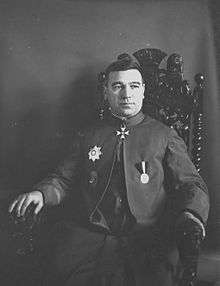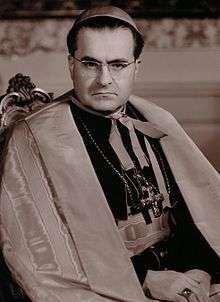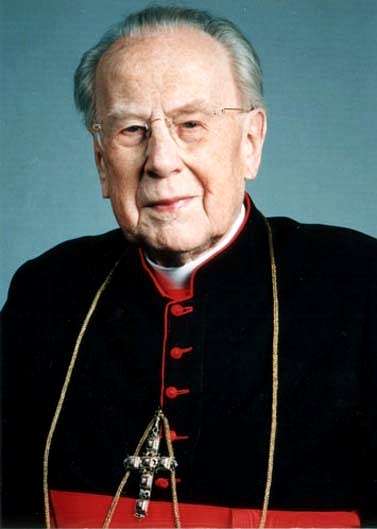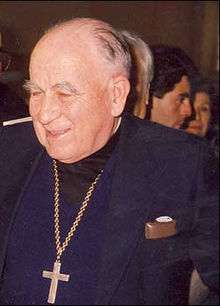Cardinals created by John XXIII
Pope John XXIII (r. 1958–1963) created 52 cardinals in five consistories.[1] Beginning at his first consistory, he expanded the size of the College beyond the limit of seventy established in 1586[2] and on several occasions announced that further increases should be expected. It rose to 88 in January 1961.[3] He named three additional cardinals in pectore, that is, secretly, but did not reveal their names before his death.
In 1962 he initiated the rule that all cardinals should be bishops. He consecrated the twelve non-bishop members of the College himself in April.[4][lower-alpha 1] He created one cardinal who later became pope, Pope Paul VI.
John’s creation of cardinals at annual consistories was a marked departure from the periods of several years that his predecessor Pius XII allowed between consistories and a return to the frequency of earlier in the 20th century.
15 December 1958



Post John announced the names of 23 new cardinals on 17 November 1958, including 13 Italians, ten of whom held offices in the Roman Curia. Though not as international a group as those named by his predecessor Pius XII, it included the first cardinals from Mexico and Uruguay. This would have increased the number of cardinals to 75, breaking the ceiling of 70 members established by Pope Sixtus V in 1586,[6][lower-alpha 2] but it only reached 74 because Cardinal José María Caro Rodríguez of Chile died before the consistory.[7] John said the increase was necessary to staff church offices properly.[8] Church law had to be waived for the new Cardinal Cicognani to join his brother Gaetano Cicognani, a cardinal since 1953, in the College.[6][9] Fietta received his cardinal's red biretta from Giovanni Gronchi, President of Italy, on 17 December.[10]
- Giovanni Battista Montini (1897–1978) (Pope Paul VI 1963–1978)
- Giovanni Urbani (1900–1969)
- Paolo Giobbe (1880–1972)
- Giuseppe Fietta (1883–1960)
- Fernando Cento (1883–1973)
- Carlo Chiarlo (1881–1964)
- Amleto Giovanni Cicognani (1883–1973)
- José Garibi y Rivera (1889–1972)
- Antonio María Barbieri, OFM Cap (1892–1979)
- William Godfrey (1889–1963)
- Carlo Confalonieri (1893–1986)
- Richard Cushing (1895–1970)
- Alfonso Castaldo (1890–1966)
- Paul Marie André Richaud (1887–1968)
- John Francis O'Hara (1888–1960)
- José Bueno y Monreal (1904–1987)
- Franz König (1905–2004)
- Julius Döpfner (1913–1976)
- Domenico Tardini (1888–1961)
- Alberto di Jorio (1884–1979)
- Francesco Bracci (1879–1967)
- Francesco Roberti (1889–1977)
- André-Damien-Ferdinand Jullien (1882–1964)
14 December 1959
Pope John announced the names of eight new cardinals on 17 November 1959, increasing the size of the College to 79,[11] including 31 Italians.[12] Cardinal Marella, papal nuncio to France, received his biretta in Paris from President Charles de Gaulle.[13]
- Paolo Marella (1895–1984)
- Gustavo Testa (1886–1969)
- Aloisius Joseph Muench (1889–1962)
- Albert Gregory Meyer (1903–1965)
- Arcadio Larraona Saralegui (1887–1973)
- Francesco Morano (1872–1968)
- William Theodore Heard (1884–1973)
- Augustin Bea (1881–1968)
28 March 1960
On 28 March 1960, Pope John created seven new cardinals, among them the first black, Japanese, and Filipino cardinals of the modern era (Rugambwa, Doi, Santos, respectively).[14] Noting the historic significance of their inclusion, he said: "Dear and venerable brothers of Tokyo, Manila and Rutabo, please tell your populations that the Pope loves them." He named three additional cardinals in pectore, keeping their identities secret.[15] Without those not named publicly, this consistory brought the number of cardinals to 85. The Italians numbered 33.[16][17]
Because Pope John failed to reveal the names of the three cardinals created in pectore before his death, their appointments never took effect.[18]
- Luigi Traglia (1895–1977)
- Peter Doi (1892–1970)
- Joseph-Charles Lefèbvre (1892–1973)
- Bernardus Johannes Alfrink (1900–1987)
- Rufino Santos (1908–1973)
- Laurean Rugambwa (1912–1997)
- Antonio Bacci (1885–1971)
16 January 1961
On 16 December 1960, Pope John announced the names of four new cardinals, including the first Venezuelan.[19] Following the consistory on 16 January 1961, there were 88 cardinals, 32 of them Italians.[3]
- Joseph Ritter (1892–1967)
- José Quintero Parra (1902–1984)
- Luis Concha Córdoba (1891–1975)
- Giuseppe Ferretto (1899–1973)[lower-alpha 3]
19 March 1962

Pope John announced the names of ten new cardinals on 17 February 1962. The consistory on 19 March left the college with 87 cardinals, including 30 Italian, 8 French, 6 Spanish, and 5 from the U.S.[21][22][lower-alpha 4]
- José da Costa Nunes (1880–1976)
- Giovanni Panico (1895–1962)
- Ildebrando Antoniutti (1898–1974)
- Efrem Forni (1889–1976)
- Juan Landázuri Ricketts (1913–1997)
- Gabriel Acacius Coussa (1897–1962)
- Raúl Silva Henríquez (1907–1999)
- Leo Joseph Suenens (1904–1996)
- Michael Browne (1887–1971)
- Joaquín Albareda y Ramoneda (1892–1966)
Notes
- John codified this and other rules for the College in Cum gravissima dated 15 April 1962.[5]
- In 1946, Pope Pius XII at his first consistory said that "the Roman Pontiffs successors of Sixtus V are not bound by his disposition if they should deem it advisable to increase or decrease that number".[6]
- At the previous conclave in 1958, Ferretto had been mentioned as one of the cardinals who might have been named in pectore.[20]
- On 19 March Pope John announced that he would consecrate as bishops the twelve members of the College not yet bishops, including two of the newest cardinals (Browne and Albareda) and a veteran of the Roman Curia Alfredo Ottaviani.[1]
References
- Cortesi, Arnoldo (20 March 1962). "Pope Elevates 10 to Cardinal Rank" (PDF). Retrieved 25 October 2017.
- Noonan, James-Charles (2012). The Church Visible: The Ceremonial Life and Protocol of the Roman Catholic Church, Revised Edition. New York: Sterling Ethos. pp. 8–9. ISBN 978-1-40278730-0.
- Cortesi, Arnoldo (17 January 1961). "4 New Cardinals Elevated in Rome" (PDF). New York Times. Retrieved 25 October 2017.
- "Catholic Cardinals Now Are All Bishops" (PDF). New York Times. 20 April 1962. Retrieved 25 October 2017.
From today therefore, perhaps for the first time in the history of the Roman Catholic Church, all Cardinals are Bishops.
- John XXIII (15 April 1962). "Cum gravissima" (in Latin). Libreria Editrice Vaticana. Archived from the original on 2 March 2013. Retrieved 11 July 2018. Cite journal requires
|journal=(help) - Cortesi, Arnaldo (18 November 2017). "Two Americans among 23 New Cardinals" (PDF). New York Times. Retrieved 25 October 2017.
- "Cardinal Caro is Dead in Chile" (PDF). New York Times. 5 December 1958. Retrieved 25 October 2017.
- Cortesi, Arnoldo (16 December 1958). "Pope Elevates 33 to Cardinalate; Deplores China Church Schism" (PDF). New York Times. Retrieved 25 October 2017.
- Pham, John-Peter (2004). Heirs of the Fisherman: Behind the Scenes of Papal Death and Succession. Oxford University Press. p. 162. Retrieved 29 March 2018.
However Canon 232 §3 of the 1917 Code of Canon Law then in force prohibited anyone having a brother who was a cardinal from being himself a cardinal.
- Gallinari, Roberto, ed. (2009). Discorsi e Messaggi del Presidente della Repubblica Giovanni Gronchi. Quaderni di Documentazione, Nuova Serie, No. 11. Rome: Segretariato della Presidenza della Republica. p. 380. Retrieved 12 July 2020.
- Cortesi, Arnaldo (17 November 1959). "Pope Selects 8 Cardinals; 2 Americans among Them" (PDF). New York Times. Retrieved 25 October 2017.
- Cortesi, Arnaldo (15 December 1959). "Pope Denounces Birth Limitation" (PDF). New York Times. Retrieved 25 October 2017.
- Cortesi, Arnaldo (17 December 1959). "Spellman Joins Rites in Vatican" (PDF). New York Times. Retrieved 25 October 2017.
- "Rite for Cardinals Completed by Pope" (PDF). New York Times. 1 April 1960. Retrieved 25 October 2017.
- "Pope Gives Red Hats to 7 New Cardinals" (PDF). New York Times. 31 March 1960. Retrieved 25 October 2017.
- "Secret Cardinals Selected by Pope" (PDF). New York Times. 29 March 1960. Retrieved 25 October 2017.
- "Pope John Names a Negro Cardinal" (PDF). New York Times. 4 March 1960. Retrieved 25 October 2017.
- Lentz III, Harris M. (2002). Popes and Cardinals of the 20th Century: A Biographical Dictionary. MacFarland & Company. pp. 1–2. Retrieved 25 October 2017.
- Cortesi, Arnaldo (17 December 1960). "4 Cardinals Named; One Is an American" (PDF). New York Times. Retrieved 25 October 2017.
- "Religion: Three in pectore". Time. 11 April 1960. Retrieved 15 December 2017.
- Cortesi, Arnaldo (18 February 1962). "10 New Cardinals Selected by Pope" (PDF). New York Times. Retrieved 25 October 2017.
- "Sketches of Men Named Cardinals" (PDF). New York Times. 18 February 1962. Retrieved 25 October 2017.
- See also
- Lentz III, Harris M. (2002). Popes and Cardinals of the 20th Century: A Biographical Dictionary. McFarland & Company. ISBN 978-0-7864-4101-3.
External links
- Papal addresses to consistories, including names
- 15 December 1958 (in Latin)
- 14 December 1959 (in Latin)
- 28 March 1960 (in Spanish)
- 16 January 1961 (in Spanish)
- 19 March 1962 (in Spanish)